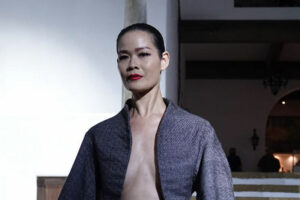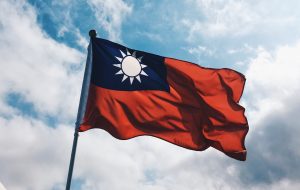Hypnotic binakol the highlight of Algodon fashion show

CLOTHES in cotton rarely make the news, having the reputation of being safe and reliable. A fashion show at the Pinto Art Museum on Feb. 5 subverted all that by showcasing cotton clothes made from the traditional abel iloko (or iloco) fabric of the Ilocos region.
While several inabel fabrics were used in the show — aptly called Algodon, Spanish for “cotton” — it’s lineup of fashion designers (namely Vic Barba, JC Buendia, Anthony Nocom, Randy Ortiz, and Pepito Albert) prominently utilized the cloth woven in the traditional yet surprisingly modern binakul pattern.
Binakul (meaning “twill” in Ilocano) “can be easily recognized by its uniform, interlocked geometric patterns that result in psychedelic optical art designs, which are said to represent the waves of the sea and, among indigenous peoples of the Cordilleras, protection against malevolent spirits,” said a Yuchengco Museum post on its 2013-14 exhibit, “Art of the Loom: Weaving the Story that is the Binakul”. According to the book Habi: A Journey Through Philippines Handwoven Textiles by Habi: The Philippine Textile Council, “Ancient tribes believed the binakul patterns protected them from vicious spirits — hence their predominant use in the rituals of the upland tribes.” These textiles were hung in homes or used as blankets while sleeping, because the optical illusions created by the lines would confuse evil spirits.
The show opened with Vic Barba’s collection, one awash with gray. Models came out to the song “Money” by The Flying Lizards. Chic jackets in gray showing off the whirlpool binakul pattern accompanied red binakul outfits, making for a striking contrast.
JC Buendia came next, showing off outfits in a pomelo-shaded binakul, ranging from exciting tops tied with string to ladylike skirt-suits and coat dresses.
Anthony Nocom, meanwhile, showed a collection with hints of yellow, such as a gray binakul jacket on a man with a double stripe of yellow running through it. Various splashes of the color were seen throughout, including in a sequined cape on a female model.
Randy Ortiz showed his binakul in a milder shade of yellow, recalling drying grass. These were shown on dresses such as a cocktail-length terno with a low neckline.
Pepito Albert ended the show with a beautifully sculpted, bell-sleeved jacket in gray, worn bare-chested by 1990s Filipino supermodel Jo Ann Bitagcol.
Abel iloko is best known as a household fabric — used in bed covers, blankets, and table runners — although it has been used in fashion more often of late. Its structure as a hand-loomed fabric made with often thick thread in a relatively loose weave, can be a challenge.
Mr. Nocom, for one, had to starch his abel iloko first to give it structure, otherwise, the fabric’s rough weave becomes loose after cutting. Mr. Ortiz expressed no such difficulty, except for the challenges of working with its width — only 22 inches as limited by the looms used to make the handwoven fabric. “The challenge that comes with the fabric is of course, the width is not really something you can play around with. It’s a very cerebral type of collection. How you manipulate it is another challenge,” said Mr. Ortiz.
Not everybody found the fabric difficult to work with. “It’s very easy,” said Mr. Barba about working with abel iloco. “It has body, and because it’s cotton, it’s very breathable.”
The fashion show was the culminating activity of work started by Pinto Art Museum founder Dr. Joven Cuanang back in 2016, who initiated a cotton development project in Pinili, Ilocos Norte. With the help of the local and national government, what initially began as two hectares devoted to cotton farming ballooned to 20. “Painstakingly, over the last six years, we nurtured it from the seed farm to fiber to fashion. Farm-produced cotton has its rightful place in our times. It is part of our cultural heritage. It should be revitalized all over our country,” said Mr. Cuanang in a speech before the fashion show.
“The idea here is to really bring this to the whole world. We’re in for a good start,” said Mr. Ortiz. — Joseph L. Garcia




